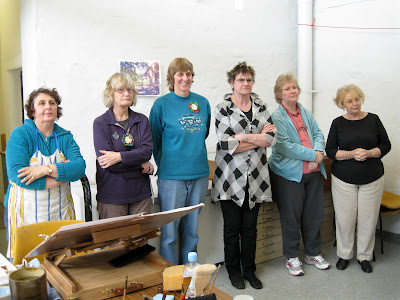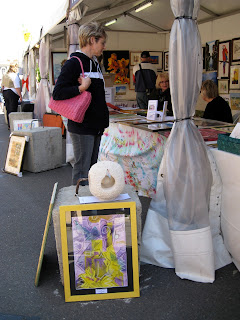Hi all,
This is not my usual art blog. I'm fed up with our treatment of refugees here in Australia and I have to let off some steam about this issue, so here goes.
In Australia we get no more than 5,000 boat people per year (while some much poorer countries take in hundreds of thousands without any sort of song and dance about it) and over 90% are deemed to be valid refugees who are eventually placed into the community after spending way too long in detention centres. I am sick of the media referring to them as "illegal". Under international law, they are not illegal immigrants they are refugees and under our long standing legally binding agreement with the united nations we have legal requirements to help them.
Many of these people have sold everything they have in the world to escape from the horror of war. They have signed away the rights to their ancestral farmlands or homes and would have nothing to return to. In many instances, when they get on the boats they do not even know the destination - they are just told they will be taken to somewhere welcoming and safe. There is often no way for them to apply to "legally" enter Australia as such places at which to apply do not exist in their country or at the refugee camps.
We get many, many more who are people who fly in and over stay visas etc. and the vast majority of them are not granted refugee status but they are allowed to be free and reside in the community while their appeals are being processed, but real refugees are prevented from reaching Australia or if they do they are locked up somewhere offshore or in Australia. This trying to keep them offshore and incarcerated practice has cost us absolutely millions and millions of dollars, money which would have been better spent elsewhere.
It makes far better to sense to process these people on shore and undetained, at way, way less expense than the cost of our past and current policies. After being held for a short time for health and quarantine checks it would be better to let them live in the community and to have them eventually enter that community mentally undamaged, grateful, hopeful and productive. Surely that is better than to have them, after years of being incarcerated and treated as criminals, being released damaged, bitter and resentful of their treatment, feeling isolated, unwelcome and therefore fearful of mixing within the community.
I am appalled that so many people who call themselves "Christians" can condone such inhumane treatment to people who have often suffered so terribly. What would the average Australian do in such circumstances if we had to flee our country, had family members beaten, raped or killed, only to flee, ending up in a refugee camp somewhere (where we could be for up to 20 years or more) and not allowed to work and where where we could be treated in some cases as badly as we were in the country from which we had fled - I think we'd try jumping on a boat and risking all too - it would be "New Zealand here we come!" and imagine how upset we'd be if the New Zealanders tried to stop us getting there or stuck us in gaol for years when we did and separated us from our families.
Lets he honest, if they were boatloads of nice white christians I bet they wouldn't be treated this way. I always used to argue with people that Australians were not racist anymore - but after the antics of ultra right wing Christians like Mr Tony Abbot, leader of the opposition and the reluctance of our Prime Minister Julia Gillard to stand up and do the right and humane thing, and as a result of the horrid and fraudulent racist emails I continually receive and the biased beat ups by the local media, I have changed my mind. I am sorry and shamed to have to say it, but I now believe Australians are racist and very much so (which is interesting considering our ancestors were all immigrants and not all of them were white either).
I am in my 50's and I have listened to all this crap all my life - when I was a kid no-one wanted the British ("whinging poms") or the greeks (because they "smelt funny" and ate "strange food"), then it was the germans (because they were all "like Hitler"), the italians (who gave us pizza for goodness sake!). After that was the vietnamese (or any other race with "slanty" eyes) and even before that it was Jews and various other european refugees. I won't even mention our attitude to our own indigineous aboriginal people. Now its people from Afganhistan, Iran, Sri Llanka, Africa, and even the people who tried to flee from the racial genocide in Indonesian controlled new guinea (and they way we historically let the people of that country down is yet another whole shameful story in itself). Hell, some of us even resent New Zealanders coming here!
I think our country is much better for having a mixture of interesting people and cultures. We are all homo sapiens after all and people should be treated humanely no matter their background, religion or colour.
Whilst I am not a Christian and do not adhere to any particular religion, I do believe you get back what you dish out - if you do good things, you get good in return - if you do not do good things and the same applies. Even if you just turn a blind eye - sometime in the future someone will turn a blind eye to you when you are in need. We have so much wealth here in Australia (even though we all whinge and think we are hard done by). We really do not know the meaning of hardship and poverty when compared to the rest of the world, yet we are becoming so mean and selfish. Where is our generosity, our humanity? To good "Christan" people like Tony Abbot (thank God he changed his mind about becoming a priest) I would put the question "what would Jesus do"? If what the bible tells us is correct - Jesus generally went out of his way to help the sick, injured, poor and troubled people that he encountered - Mr Abbot should remember that it was the selfish and the moneylenders that he had an issue or two with.
And look at the fuss we are making over a well off Australian 14 year old being held in detention in Indonesia for taking drugs, yet we have been locking up refugee kids and young crew members from fishing/smuggling boats for years. There are apparently about 50 or so approx 14 year old kids being held by us because they had been hired as crew by people smugglers. These kids would have been very poor and looking for any sort of paid work or their parents would have arranged it for them - they probably didn't even know what their cargo was to be when they were hired, but even if they did they would have needed the money. We've been putting refugee kids in "detention centres" (just another word for a gaol) for years. We have kept loved ones apart and split families for years.
I am sick to death of receiving hate emails aimed at refugees and any one who is not a nice white christian. I cannot plead for their cause as eloquently as someone like the human rights barrister Julian Burnside QC ( http://en.wikipedia.org/wiki/Julian_Burnside ) but I can forward this message from the "GET UP" organisation.
Call me idealistic but I grew up watching "Star Trek" and I have always hoped that one day humanity would grow up and reach an age when we would all share and live happily together and look after this world and every living thing on it. With all the greed and selfishness I am seeing around me these days and peoples unwillingness to help each other, it is becoming harder and harder to remain optimistic, but I haven't quite given up yet (although listening to Tony Abbott talk makes it very hard!). So come on Australia, don't be fearful and selfish - enrich us all by having a heart and holding out a helping hand to these people instead of offering them a detention cell.
I'll get off my soap box now - if you don't agree with this that is your right - if you have already signed the petition then yaayy good on ya, and if you haven't seen it and agree with it then please sign it and also forward it to someone else who you feel may care about the plight of these people. If you live overseas and want to sign it and let the Australian Government know what you think of their disgraceful record, then please do so.
http://www.getup.org.au/detention-disgrace
Heather.
PS For those who have been sent the some of the nasty emails one of which claims asylum seekers get more money than pensioners click here for some facts as to what they really receive as researched by from David Kosh of Chanel 7 Sunrise (and I draw your attention to the fact they can't qualify to receive the welfare payment if they are in detention). You will find similar information on the Govt websites and the refugee council ones.
http://kochie.com.au/the-real-benefits-for-asylum-seekers-in-australia





























































